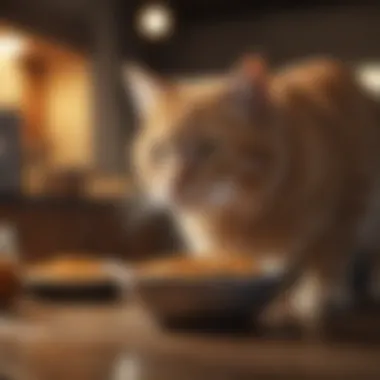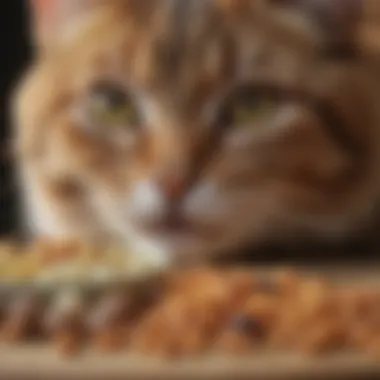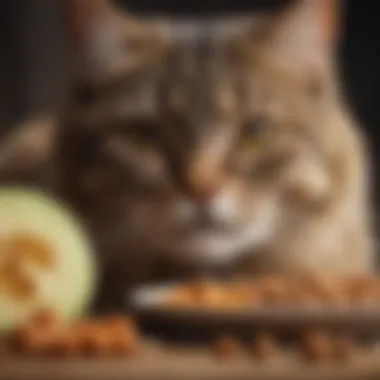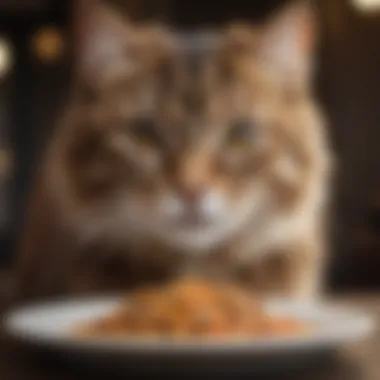Optimal Nutritional Solutions for Picky Senior Cats


Intro
Finding the right food for senior cats, especially those that are picky eaters, can be a challenging task for many pet owners. As cats age, their nutritional needs change significantly. This evolution requires careful consideration when selecting suitable food that meets both their health needs and personal preferences. Senior cats often experience decreased appetite or become finicky with textures and flavors, making it crucial to find options they will enjoy. A thoughtful approach to nutrition can greatly improve their quality of life.
Animal Profile
General Overview
Senior cats typically refer to felines aged seven years and older. At this stage, their metabolism slows down, and their body undergoes various changes that can influence their eating habits. Increased sensitivity to flavors and textures, along with health issues related to aging, often contribute to their selectiveness in food choices. It is vital to understand these factors to make appropriate dietary adjustments.
Habitat and Distribution
Cats are domesticated animals found across the globe, differing in habitats from urban to rural areas. In a domestic environment, senior cats primarily live indoors where factors like temperature, comfort, and safety affect their eating habits. This setting underscores the importance of choosing food that is not just nutritious but also appealing to encourage consistent feeding.
Nutritional Needs of Senior Cats
As cats get older, their nutritional requirements shift. A diet rich in high-quality protein is essential to maintain muscle mass. Adequate levels of fatty acids support skin and coat health, while fibers can assist in digestive health. Additionally, senior cats often need fewer calories due to reduced activity levels.
Common ingredients that appeal to picky eaters include chicken, fish, and beef, often in a soft or gravy-rich format. Understanding these preferences helps in selecting the right foods.
Feeding Strategies for Picky Eaters
It may be helpful to experiment with different food types, like wet food or dry kibble, in varied flavors. Some cats prefer certain textures, while others may have specific preferences regarding moisture content. Gradual transitions between foods can prevent digestive upset and encourage a more favorable acceptance of new items. Mixing in a favorite food can sometimes ease the shift to healthier or alternative options.
A tailored nutrition strategy can dramatically enhance your senior cat's appetite and overall wellness.
Understanding the Nutritional Needs of Senior Cats
Understanding the nutritional needs of senior cats is crucial for ensuring their health and well-being. As cats age, their bodies undergo various changes that affect their nutritional requirements. Older cats often experience a decline in metabolism, changes in digestion, and potential issues with dental health. These factors necessitate a tailored approach to their diet, making the selection of food vitally important.
The Importance of Age-Specific Nutrition
Age-specific nutrition addresses these changes directly. Senior cats require diets that are lower in calories yet higher in certain proteins to maintain muscle mass. Additionally, a diet rich in omega fatty acids can improve joint health, which can become a concern with aging. Nutrient-dense formulations can also help support vital organs such as the kidneys, which may become less efficient over time.
In addition, the texture and flavor of food can influence the eating habits of older felines. Many senior cats become fussy eaters or have difficulty chewing hard food items. Soft, moist options or even specially formulated senior dry foods can enhance palatability and encourage consumption.
Common Nutritional Deficiencies in Senior Cats
Senior cats are prone to specific nutritional deficiencies that can significantly impact their health. For instance, many older cats do not consume adequate levels of vitamins and minerals essential for their aging bodies. Common deficiencies include:
- Taurine: Critical for heart health, taurine is often insufficient in typical diets.
- Vitamin E: Important for immune function and skin health, but often lacking.
- B Vitamins: Necessary for energy metabolism, which can decline with age.
- Fiber: Essential for digestive health; many senior cats do not consume enough.
These deficiencies can lead to serious health issues, such as cardiovascular diseases or digestive problems. Awareness of these specific needs helps caregivers select the most appropriate food, ensuring that senior cats maintain their vitality and quality of life.
Characteristics of Picky Eater Senior Cats
Understanding the characteristics of picky eater senior cats is crucial for identifying the best nutritional solutions for them. These cats often exhibit unique behavior patterns and food preferences that can complicate the process of selecting suitable meals. Recognizing and addressing these specific traits can significantly enhance their overall well-being and ensure they receive the essential nutrients they need.
Behavioral Attributes of Picky Eaters
Senior cats that are picky eaters may display a range of behavioral attributes that reflect their preferences and comfort levels around food. These behaviors can stem from age-related factors, health issues, or previous dining experiences. Important behavioral aspects include:
- Evasion of Food: Picky eaters may avoid food offerings altogether, especially if they are uncertain about the taste or texture.
- Selective Sniffing: Often, these cats will carefully sniff the food before taking the first bite, demonstrating their preference for specific aromas.
- Repeated Sampling: Some cats may take a bite, chew briefly, and then refuse to continue eating. This behavior can indicate dissatisfaction with flavor or texture.
Additionally, a calming environment is vital for these cats. Stress factors such as loud noises or sudden movements can deter them from trying new foods. Ensuring a quiet and safe dining space can help alleviate anxiety, making meals more appealing.


Common Food Preferences and Dislikes
The preferences and dislikes of picky older cats can be quite varied. Understanding these nuances helps caregivers make better choices when selecting food. Common trends among picky eater senior cats include:
- Textures: Many senior cats prefer wet food over dry food due to the moisture content and softer texture, which might be easier for them to chew.
- Flavors: Beef, chicken, and fish tend to be popular flavors, but individual cat preferences may diverge. Some might lean towards more unique flavors, while others may reject strong aromas.
- Temperature: Surprisingly, food served at room temperature is often more appealing than cold or hot. Providing a warm dish can enhance the aroma and encourage eating.
- Ingredients: Picky eaters may avoid foods with certain ingredients, such as grains or specific meats. Reading ingredient labels can help identify those components.
Key Ingredients to Look for in Senior Cat Food
Choosing the right cat food for senior picky eaters is not just a matter of preference; it significantly affects their health and well-being. At this stage of life, cats require specific nutrients that fortify their body, ensuring a good quality of life. Therefore, it is crucial to understand the key ingredients that effectively meet these needs. High-quality ingredients help maintain energy levels, support digestion, and promote overall health. The selection of these ingredients makes a substantial difference in how well a cat adapts to their diet, especially for those with discerning tastes.
High-Quality Proteins and Fats
Proteins serve as the building blocks for a senior cat's muscles and tissues. Senior cats often need diets higher in protein compared to younger cats. This helps in maintaining muscle mass and improving immune response. Look for sources like chicken, turkey, or fish. These proteins should be the primary ingredients in the food you choose. Moreover, fats are also essential. They provide energy and facilitate the absorption of fat-soluble vitamins. Healthy fats such as omega-3 and omega-6 fatty acids support skin and coat health while offering anti-inflammatory benefits. For picky eaters, a food rich in these proteins and fats often enhances taste, making it more appealing.
Hydration and Moisture Content
Sufficient hydration is vital for senior cats, as dehydration can lead to numerous health problems, including kidney issues. Wet cat food generally contains over 70% moisture, which aids in hydration. In contrast, dry food is low in moisture and may not sufficiently help hydrate your cat. Opting for wet food can also be beneficial for picky eaters who may enjoy the aroma and texture of moist meals. It is worth noting that incorporating wet food alongside high-quality dry options can create a balanced diet, ensuring proper hydration and satisfaction during meal times.
Digestible Carbohydrates and Dietary Fiber
While cats are obligate carnivores, carbohydrates do have a place in their diet. They can serve as a source of energy when they are easily digestible. Look for grains like oatmeal or rice that add necessary carbohydrates without overwhelming the diet. At the same time, dietary fiber is important for digestive health. A senior cat may experience changes in digestive efficiency, so including fiber can help maintain regular bowel movements. Ingredients such as beet pulp or pumpkin are great additions for improved digestion, making food more enticing for those fussy eaters.
Essential Vitamins and Minerals
Vitamins and minerals are vital for maintaining overall health in senior cats. Antioxidant-rich ingredients can combat oxidative stress, particularly vitamins E and C. Furthermore, specific minerals like calcium and phosphorus are crucial for maintaining strong bones and teeth. Omega-3 supplements can also enhance cognitive functions, which is important for aging felines. When selecting cat food, look for options that list these vitamins and minerals on the packaging, as their availability plays a significant role in a senior cat's quality of life.
Choosing a diet high in quality ingredients can drastically enhance the health and well-being of senior cats.
In summary, when selecting the right food for picky senior cats, focus on high-quality proteins, moisture content, digestible carbohydrates, and essential vitamins and minerals. These elements contribute to a balanced diet that keeps your feline friend happy and healthy.
Recommended Brands for Picky Senior Cats
When it comes to selecting cat food for senior cats who are picky eaters, the choice of brand is crucial. Brands that cater specifically to the unique needs of older cats can provide nutrients that enhance health while also addressing their selective culinary preferences. High-quality brands often invest in research and development to ensure their products meet the specific requirements of aging felines.
Many senior cats face challenges such as decreased taste sensitivity or dental issues, which can complicate feeding. A recommended brand can provide assurances of quality ingredients and formulate their products with these factors in mind. Selecting proper food can also help prevent common health issues that arise in older age, such as obesity, kidney disease, and digestive problems. Thus, considering brands that focus on senior cats can offer significant benefits.
"Instead of compromising on quality, choose brands that prioritize the health and palatability for senior cats."
Brand A: An Overview
Brand A is well-known in the pet food industry and has gained a reputation for its commitment to senior cat nutrition. This brand utilizes high-quality meat sources as the primary ingredient in its recipes. The formula includes omega fatty acids which support skin and coat health while also promoting joint mobility. Additionally, Brand A focuses on the right balance of vitamins and minerals, vital for senior cat health, ensuring each meal is nutrient-dense yet palatable for discerning tastes.
Brand B: Unique Selling Points
Brand B distinguishes itself with its innovative approach to cat food. Their recipes are tailored for senior cats by integrating natural flavors and aromas that appeal to picky eaters. The brand invests in crafting unique formulations that include ingredients such as real chicken and salmon, which are richer in protein. Furthermore, they provide grain-free options made with wholesome vegetables to enhance digestive health without compromising on taste. Such choices are crucial for cats who demonstrate disharmony with traditional ingredients.
Brand C: Palatability and Nutrients
Brand C emphasizes palatability alongside balanced nutrition. The company ensures that their senior cat food is not just good for health, but also enjoyable to eat. They conduct rigorous taste tests when developing new formulas. This ensures that picky eaters find their meals appetizing, which can be a challenge in older cats. With ingredients rich in essential amino acids, the brand helps to maintain muscle mass and energy levels, vital for healthy aging. Their blend of nutrients not only ensures cats are well-fed but also supports their overall well-being.
Brand D: Formulations for Sensitive Stomachs
For senior cats with more delicate stomachs, Brand D offers specialized formulations. This brand prioritizes digestibility and uses limited ingredients to prevent gastrointestinal stress. Each formulation is carefully crafted to reduce allergens and includes ingredients that promote gut health. Probiotics are integrated into their recipes, supporting a healthy digestive system. By focusing on sensitive stomachs, Brand D provides a haven for senior cats who struggle with standard diets, ensuring comfort and satisfaction at mealtime.


Texture and Flavor Options That Appeal to Picky Eaters
Understanding the right texture and flavor options is vital for preparing meals for picky senior cats. As cats age, their preferences can change, along with their physical and dietary needs. Senior cats often develop preferences for certain textures, which can influence their willingness to eat. This section will help you identify the aspects of food textures and flavors that are most appealing to these discerning eaters.
Wet vs.
Dry Cat Food: Benefits and Drawbacks
When it comes to choosing between wet and dry cat food, both options have their own set of advantages and disadvantages.
Wet cat food can be particularly beneficial because:
- It has high moisture content, which is important for senior cats that might be prone to dehydration.
- The softer texture is easier to chew, making it more suitable for those with dental issues.
- Many cats find the aroma of wet food more appealing.
In contrast, dry cat food has its own merits:
- It is typically more convenient to store and can be left out for longer periods without spoiling.
- The crunchy texture can help with dental health by reducing tartar build-up.
- Dry food often contains more calories per serving, which can aid senior cats needing to maintain weight.
Ultimately, the decision may vary based on your cat's specific preferences and needs. It's crucial to consider how each type aligns with your cat's health and lifestyle.
Popular Flavors Among Senior Cats
Flavor can significantly impact a senior cat's willingness to eat. Here are some common preferences noticed among picky senior cats:
- Chicken: This flavor is widely favored and is often associated with high palatability.
- Tuna: Many cats enjoy the strong smell and flavor of tuna, though it should be offered in moderation due to its high mercury content.
- Lamb: Some cats prefer lamb due to its distinct taste, which can be a good alternative for cats that are bored with more common proteins.
- Salmon: The rich flavor makes it an appealing choice, but it’s essential to be cautious of allergies in some cats.
Incorporating these flavors in well-balanced formulations can encourage adequate nutrient intake. By observing your cat's reaction to various tastes, you can curate meals that truly resonate with their unique preferences.
Cats often exhibit strong preferences, and knowledge of these can ease feeding challenges.
Choosing the right texture and flavor is essential in securing your senior cat's nutrition. A tailored approach will contribute not just to their physical health but also to their overall satisfaction with meals.
Feeding Strategies for Picky Eater Senior Cats
Understanding feeding strategies is vital when it comes to catering to senior cats with discerning palates. Picky eaters often refuse to eat, leading to nutritional deficiencies and health issues. Therefore, employing effective feeding strategies can ensure that these cats receive the essential nutrients they require for their well-being. Moreover, engaging with their dietary preferences can help improve their overall health and encourage a better eating routine.
Gradual Transition to New Foods
Transitioning a senior cat to a new diet is essential, especially for picky eaters. A sudden switch from one food to another can lead to stress or gastrointestinal issues, which may further deter them from eating. To avoid such consequences, it is advisable to make dietary changes gradually.
Begin by mixing a small amount of the new food with their current food. Over the course of several days, gradually increase the proportion of the new food while decreasing the old food. This method allows the cat to acclimate to the new flavor and texture comfortably. It is important to observe the cat's reaction to the new food; adjustments may be required based on their preferences.
Additionally, if a cat shows signs of aversion, it may be beneficial to revert back to the original food and try again later. Patience is key in this process, as some cats may require more time to adapt than others.
Mixing Foods for Enhanced Palatability
For picky eaters, combining different types of food can often enhance flavor and promote consumption. Mixing wet and dry foods can provide varied textures that may entice the cat. Wet food often carries stronger aromas and more moisture content, which makes it appealing to many cats.
Another approach is to incorporate toppings, such as small pieces of cooked poultry or fish. These additions can enhance the taste profile and make the meal more inviting. It’s important to ensure that any added ingredients are safe for cats and do not contain harmful substances or seasonings.
Furthermore, using warm food can sometimes increase its scent and make it more appetizing. Simply warming the food in the microwave for a few seconds (ensuring it is not too hot) can boost the appeal significantly.
Scheduled Feeding vs.


Free-Feeding
Deciding between scheduled feeding and free-feeding can significantly impact a senior cat’s eating habits. Scheduled feeding involves providing meals at regular intervals throughout the day. This method allows for better control over portion sizes and helps to monitor the cat's food intake. Most veterinarians recommend this approach for senior cats, especially those with specific dietary needs.
On the other hand, free-feeding allows cats to eat whenever they please. While this may seem convenient, it can lead to overeating or food wastage if the cat does not consume all the food. Moreover, there’s a risk that picky eaters may ignore their meals altogether if they feel they have the luxury of time.
Ultimately, the choice between these strategies depends on the individual cat's behavior and overall health. Monitoring how well a cat adapts to either method can provide insights that help in deciding the best approach moving forward.
Monitoring dietary behavior is crucial for understanding optimal feeding strategies for senior picky eater cats.
Monitoring Health and Dietary Response
Monitoring the health and dietary response of senior cats is vital in ensuring they receive appropriate nutrition. Older cats often face unique challenges related to changes in metabolism, dietary preferences, and overall health. These factors can influence their eating habits, making it crucial for owners to remain vigilant about their dietary responses. This monitoring helps in evaluating whether the selected food meets their nutritional needs and if changes need to be made to their diet.
Signs of Nutritional Adequacy
Recognizing the signs of nutritional adequacy is essential for maintaining a senior cat’s health. Indicators can include:
- Stable weight: Consistent weight is a good sign food is providing necessary calories.
- Shiny coat: A healthy coat can often indicate a good diet rich in essential fatty acids.
- Active behavior: Energy levels should remain relatively stable.
- Regular bowel movements: Consistency in stool can suggest the food is well-digested.
- Good hydration: Cats often do not drink enough water, so hydration status is essential.
If any of these signs become unacceptable, it may warrant an examination of the current diet.
When to Consult the Veterinarian
Consulting a veterinarian should happen in various situations related to dietary concerns. It's advisable to seek professional advice when:
- The cat shows signs of weight loss or gain suddenly.
- There are changes in appetite that persist for more than a couple of days.
- The cat exhibits signs of gastrointestinal distress, such as vomiting or diarrhea.
- Changes in energy levels become noticeable.
- There are signs of dehydration, such as dry gums or lethargy.
It is always better to err on the side of caution when it comes to the health of aging pets.
By seeking veterinary guidance promptly, owners can ensure they make informed feeding choices tailored to their senior cat's needs.
The End: Striking a Balance
In the journey of providing optimal nutrition for senior cats who are picky eaters, a balance must be achieved between taste and nutrition. Aging felines often exhibit selectivity in their dietary choices, making it essential to present options that satisfy both their palates and their unique health requirements. This article emphasizes several key elements that can guide cat owners in making informed food selections for their senior companions.
Firstly, understanding the nutritional needs of older cats is crucial. These needs differ markedly from younger cats. Nutritional deficiencies can easily develop if the food offered lacks essential vitamins and minerals. Thus, it’s vital to ensure that the selected cat food is specifically formulated for senior felines.
Moreover, recognizing individual preferences and dislikes can greatly influence feeding success. For picky eaters, presenting a range of textures and flavors can help identify the most appealing options. This understanding fosters a positive feeding experience, ensuring that the cats consume adequate nutrients each day.
Lastly, implementing effective feeding strategies, such as gradual transitions to new foods and mixing various options, can improve acceptance of nutritious diets. Monitoring health and dietary responses is equally important, as it provides insights into whether the chosen food meets the cat's specific needs.
"Successful nutrition for senior cats hinges not just on what they eat, but on how they feel about it."
Final Thoughts on Cat Nutrition
The final objective in managing the diets of senior cats revolves around creating an enjoyable feeding experience. Owners should focus on integrating high-quality ingredients while being aware of specific dietary requirements. Nutritional labels on pet food can be overwhelming, yet careful scrutiny of these ingredients can reveal essential information about protein sources, moisture content, and the presence of beneficial additives.
Also, it's valuable to stay informed about new research on feline nutrition. This knowledge allows owners to make educated decisions, maximizing the health benefits for their cats. A balanced diet combined with regular veterinary consultations ensures that senior cats lead longer, healthier lives.
Encouraging Healthy Eating Habits
Promoting healthy eating habits among senior picky eaters requires patience and ingenuity. Owners may begin by slowly introducing new foods to their felines. This gradual approach can reduce anxiety and resistance to unfamiliar flavors or textures.
Consider these strategies:
- Mix foods gradually: Combine small amounts of new food with familiar favorites. This trick can encourage cats to try the new meal without feeling overwhelmed.
- Establish a routine: Consistency in meal times establishes predictability, which may help reduce hesitance.
- Experiment with warming food: Sometimes, gently warming wet food can enhance its aroma, making it more appealing.
- Use puzzles or feeding toys: Engaging cats in their feeding process can stimulate interest in their meals.
By fostering an environment that supports healthy choices and practices, cat owners can enhance their pet's willingness to engage with food. Over time, these strategies can train cats to embrace nourishment as an enjoyable part of their daily routine.















